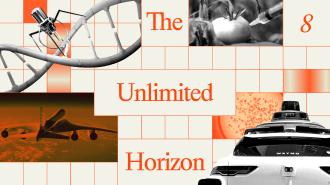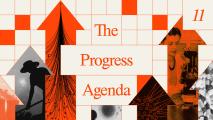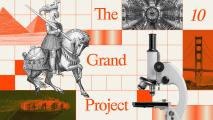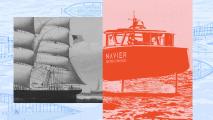The following is Chapter 8, Section 2, from the book The Techno-Humanist Manifesto by Jason Crawford, Founder of the Roots of Progress Institute. The entirety of the book will be published on Freethink, one week at a time. For more from Jason, subscribe to his Substack.
Is there really that much more progress to be made in the future? How many problems are left to solve? How much better could life really get?
After all, we are pretty comfortable today. We have electricity, clean running water, heating and air conditioning, plenty of food, comfortable clothes and beds, cars and planes to get around, entertainment on tap. What more could we ask for? Maybe life could be 10% better, but 10x? We seem to be doing just fine.
Most of the amenities we consider necessary for comfortable living, however, were invented relatively recently; the average American didn’t have this standard of living until the mid-20th century. The average person living in 1800 did not have electricity or plumbing; indeed the vast majority of people in that era lived in what we would now consider extreme poverty.1 But to them, it didn’t feel like extreme poverty: it felt normal. They had enough food in the larder, enough water in the well, and enough firewood to last the winter; they had a roof over their heads and their children were not clothed in rags. They, too, felt they were doing just fine.2
Our sense of “enough” is not absolute, but relative: relative to our expectations and to the standard of living we grew up with. And just as the person who felt they had “enough” in 1800 was extremely poor by the standards of the present, we are all poor by the standards of the future, if exponential growth continues.
We, or our descendants, can all be fabulously rich in the future by the standards of today.
Future students will recoil in horror when they realize that we died from cancer and heart disease and car crashes, that we toiled on farms and in factories, that we wasted time commuting and shopping, that most people still cleaned their own homes by hand, that we watched our thermostats carefully and ran our laundry at night to save on electricity, that a foreign vacation was a luxury we could only indulge in once a year, that we sometimes lost our homes to hurricanes and forest fires.
Putting it positively: we are fabulously rich by the standards of 1800, and so we, or our descendants, can all be fabulously rich in the future by the standards of today.
But no such vision is part of mainstream culture. The most optimistic goals you will hear from most people are things like: stop climate change, prevent pandemics, relieve poverty. These are all the negation of negatives, and modest ones at that—as if the best we can do in the future is to raise the floor and avoid disaster. There is no bold, ambitious vision of a future in which we also raise the ceiling, a future full of positive developments.
It can be hard to make such a vision compelling. Goals that are obviously wonderful, such as curing all disease, seem like science fiction impossibilities. Those that are more clearly achievable, such as supersonic flight, feel like mere conveniences. But science fiction can come true—indeed, it already has, many times over. We live in the sci-fi future imagined long ago, from the heavier-than-air flying machines of Jules Verne and H. G. Wells to the hand-held communicator of Star Trek.3 Nor should we dismiss “mere” conveniences. Conveniences compound. What seem like trivial improvements add up, over time, to transformations. Refrigerators, electric stoves, washing machines, vacuum cleaners, and dishwashers were conveniences, but together they transformed domestic life, and helped to transform the role of women in society.4 The incremental improvement of agriculture, over centuries, eliminated famine.
So let’s envision a bold, ambitious future—a future we want to live in, and are inspired to build. This will be speculative: not a blueprint drawn up with surveyor’s tools, but a canvas painted in broad strokes. Building on a theme from Chapter 2, our vision will be one of mastery over all aspects of nature:
Mastery over biology
In the bold, ambitious future, we might cure all disease.
We are already making progress against cancer and heart disease, by far the largest causes of death in wealthy countries.5 Future progress against cancer might come from early detection via blood or imaging, mRNA cancer “vaccines,” improved CAR-T cell therapy, or even direct editing of cancerous DNA; for heart disease, it might come from advances in surgery, new valve replacement techniques, or drugs such as PCSK9 inhibitors and GLP-1 agonists.6 Better gene editing toolkits, and delivery mechanisms to get them to the right cells, might cure genetic diseases such as muscular dystrophy, cystic fibrosis, sickle-cell anemia, or Huntington’s—indeed, treatments for some of these are already approved or in development.7 Artificial kidneys grown from our own stem cells might replace diseased ones.8 We might cure, or learn how to prevent, Alzheimer’s and other neurodegenerative diseases. We might cure metabolic diseases, and end obesity. We might finally discover the formula for optimal nutrition, creating food that is both delicious and perfectly healthy, and ending the curse of junk food.
We might end pandemics. Far-UVC light might be used to kill airborne pathogens, sanitizing our air the way that chlorine and filtration sanitized our water over a century ago.9 Monitoring of wastewater in cities and airports could give early warning of growing threats.10 CRISPR-based gene drives could eliminate the species of mosquitoes that carry human diseases.11 More ambitiously, biotech founder and sci-fi author Hannu Rajaniemi has proposed an “immune-computer interface,” a way to artificially augment our immune systems.12 In his novel Darkome, he imagines a wearable device: a miniature mRNA synthesizer with a wi-fi connection, strapped to your arm.13 In this world, any time a new pathogen is detected anywhere on the planet, everyone wearing one of these devices can get the vaccine for it before it has time to spread.
We might enhance ourselves to levels of functioning far above baseline.
We might even cure aging. We rarely think of aging as a disease; we accept it as natural and inevitable. But there is no biological reason why we have to age—why we have to lose strength and muscle mass, suffer worse fractures from weaker bones, face increased risk of cancer and infection, lose our hearing and our eyesight and our energy and our fertility. A new drug, a genetic therapy, or the right cocktail of transcription factors14 might grant everyone as many years of healthy, vigorous life as they choose.
And to be truly ambitious, we should go beyond eliminating disease, beyond simply maintaining ourselves at a normal, baseline state of health. We might enhance ourselves to levels of functioning far above baseline. We should be able to achieve exceptional strength, endurance, flexibility, and energy. We should all be as attractive as we want to be, with the body composition, skin quality, and hair that we prefer. We should all have exceptional intelligence, creativity, memory, focus, willpower, resilience, and mood. We could all be “short sleepers,” those rare genetic individuals who thrive on four hours of sleep a night; perhaps we will even learn how to eliminate the need for sleep entirely.15 Almost none of this even requires going beyond demonstrated human limits for these qualities: if we could simply bring the average person up to 99th percentile on all of these axes at once, it would make them effectively superhuman.16
Nor need we stop at optimizing ourselves. We might optimize our crops and livestock as well: for efficiency, nutrition, taste, and hardiness; for resistance to disease and pests without the need for chemicals.17 That is, assuming we have livestock in the future—we might not, if we can invent more efficient ways to produce meat, by growing it in a lab, or if someday we can synthesize all our food directly from chemicals, without needing to rely on growing entire organisms that we only eat a part of.18 We might even invent entirely new types of foods, both meat and vegetable, with undiscovered flavors never found in nature. Nor need we stop at food: bioengineering could give us new materials with novel properties or applications, such as super-strong fibers derived from spider silk.19
Mastery over information
I’ve already described why AI has the potential to create a new economic era. Let’s consider what this might look like.
In the bold, ambitious future, AI workers may have enough different skillsets to enable entire virtual businesses. Today, if you have an idea for a software application, you might have to hire engineers to develop it, product managers to write the specifications, designers to create the interface, marketers to launch the product, and sales representatives to close deals—presuming you don’t have all of those skills yourself. To hire those people takes millions of dollars, so you have to figure out how to network your way to VCs and pitch them—presuming you aren’t independently very wealthy. This process takes years.20 In the future, you might be able to spin up virtual workers for all the above functions on demand. Instead of 2 years and $2 million to launch a simple app, it might take 2 months and $20k. This would be accessible to many more people, and for many more applications. Many custom applications might be created that don’t even rise to the level of businesses, to run every reading group, little league, and knitting club.
Professional services might be democratized. Today only the wealthy can afford the best lawyers or doctors, or an accountant to do their taxes, or a therapist to listen to their troubles. In the future, first-rate services might be available to almost everyone—just as the average person now consumes fruits, spices, or clothing that once were the prerogative of royalty.
Another luxury service the wealthy can afford is private tutoring. In the bold, ambitious future, every student might receive personalized instruction. Teaching could follow the student’s interests, on a daily basis, to optimize for motivation. When a student is struggling, the lesson could be slowed down, simplified, or repeated as necessary for mastery; when a student is excelling, the lesson could be sped up or taken to the next level. Every student might be able to achieve their maximum potential.
A very small team, or even one person working alone, might be able to create an entire feature-length film, for a fraction of a percent of the budget of today’s blockbusters. This could unleash a flood of creativity, make an end run around the traditional media gatekeepers, and liberate us from the Hollywood rut of sequels, franchises and remakes.
Language might no longer be a barrier, anywhere, for any reason.
AI matchmakers might help us make all kinds of connections, both personal and professional—introducing us to people we’d never otherwise have met, and triaging out the introductory meetings that would just be a mutual waste of time. And at the other end of the pipeline, AI might help us close all kinds of deals—buying a car, selling a house, negotiating a job offer or a VC term sheet—saving us from processes that most of us find uncomfortable, and leveling a playing field that is currently tilted in favor of the more experienced party in each of these deals.
Language might no longer be a barrier, anywhere, for any reason. Imagine knowing every language in the world. Imagine being able to read any book, article, paper, essay, or blog post, no matter what language it was written in. Imagine being able to listen to any talk, podcast, or news report, with the “Babel fish” from the Hitchhiker’s Guide as your interpreter. Imagine this ability granted to everyone on Earth, beginning to dissolve the barriers between peoples and cultures.
Mathematics might soon be, in essence, completed: all open questions answered, from the Riemann hypothesis to the twin prime conjecture to the P vs. NP question.21 Unlike other branches of science, this would require no laboratory experiments, just a lot of computation; and the results could be verified via formal proofs—no need to trust the AI’s intuition or worry about hallucinations.
All of the above is based only on AI that runs in the cloud, or on your phone or laptop. A new generation of robotics, leveraging deep learning techniques and modern language and vision models, might dramatically expand what physical work can be automated.22 The obvious possibilities, already thoroughly envisioned by science fiction, need not be rehearsed here.
Also, all of the above is envisioning only our current screen-and-keyboard interfaces to software. Already AI is being incorporated into wearable electronics, such as voice-activated pendants or camera-enabled Ray Bans.23 An AI that hears what you hear, sees what you see, and is always available for a conversation might be able to assist you better than any butler or servant.
Or, someday, we might perfect brain-computer interfaces and connect to the machines directly. Already experimental Neuralink devices have allowed a paralyzed man to control a computer; other devices are being tested to restore sight to the blind.24 Information tools, from cuneiform to smartphones, have always acted as extensions of our minds, and the more ubiquitous and accessible they are, the more they can augment our cognitive abilities. The logical end of that progression is to merge with the machines.
Mastery over space
Starting with the first passenger railroads around 1830 through the deployment of passenger jets in the 1960s, powered vehicles have dramatically shrunk travel times, at all scales, from the neighborhood to the world. Yet we are still limited by distance. It matters enormously what city you live in, because it’s expensive and time-consuming to travel outside of it; even within a metro area, people are limited by commute.
Increases in speed and convenience don’t just save us time: they expand our world, as we begin to take trips that were inaccessible before. Across a wide variety of societies and transport systems, from rural African villages to modern US and Singapore, people spend about an hour a day on total travel.25 So when speed doubles, rather than cutting our travel time in half, it instead doubles our travel radius, opening up more of the world to us—and since area goes as the square of the distance, doubling a travel radius actually opens up four times as much of the world.26
The next great frontier in speed is supersonic passenger flight. At the speed of Mach 1.7 planned for the airliner from Boom Supersonic, you could fly from New York to London in under 4 hours, or San Francisco to Tokyo in 6 and a half.27 This possibility was proven more than 50 years ago with Concorde; it has merely been languishing for want of updated technologies and a profitable business model.
Passenger jets, however, will always have the problems of trains, buses, and other forms of mass transit: they go from station to station, not from your origin to your destination; and they come and go on their schedule, not yours. The ultimate in travel convenience is a personal vehicle: one that leaves whenever you’re ready, starts from wherever you are, takes you wherever you’re going, and lets you stash all your stuff in the trunk. In the bold, ambitious future, we might create transportation that combines the convenience of personal vehicles with the speed of air travel: the “flying car.”
Increases in speed and convenience don’t just save us time: they expand our world.
Like most people, I was initially skeptical of this idea, seeing it as a fantasy of science fiction. I changed my mind after reading J. Storrs Hall’s Where Is My Flying Car? Hall recounts the history of flying car research and development, catalogs design approaches, models engineering tradeoffs and travel times, and concludes that there is no technological or economic reason why we can’t have flying cars with existing technology.28
The vehicles of the future might also be autonomous—a huge boost to convenience, cost, privacy, and safety. Already, self-driving robotaxis are doing business on the streets of San Francisco, Los Angeles, Austin, Atlanta, and Phoenix.29 Early data shows that Waymos are far safer than human drivers—unsurprising to anyone who’s taken a ride in one and noticed how mild-mannered its driving style is. Flying cars might also need autonomy, for safety and to obviate turning everyone into pilots. And autonomous trucking might reduce the cost of freight by over 40%.30
But all of the above is just about getting around Earth. Sooner or later, it will be time to make a serious foray into space.
Rocketry, after peaking during the Apollo program and languishing thereafter, is finally advancing again in recent years, mostly thanks to SpaceX. After decades of launch costs hovering around $10,000/kg, Falcon 9 lowered costs to $2,600/kg and Falcon Heavy to $1,500/kg.31 This has driven more than a 20x increase in the annual number of objects launched into space. Many of them are Starlink satellites providing high-speed internet service to air passengers, rural homes, van-lifers, fishing boats, oil rigs, scientific outposts, disaster zones, and battlefields.32
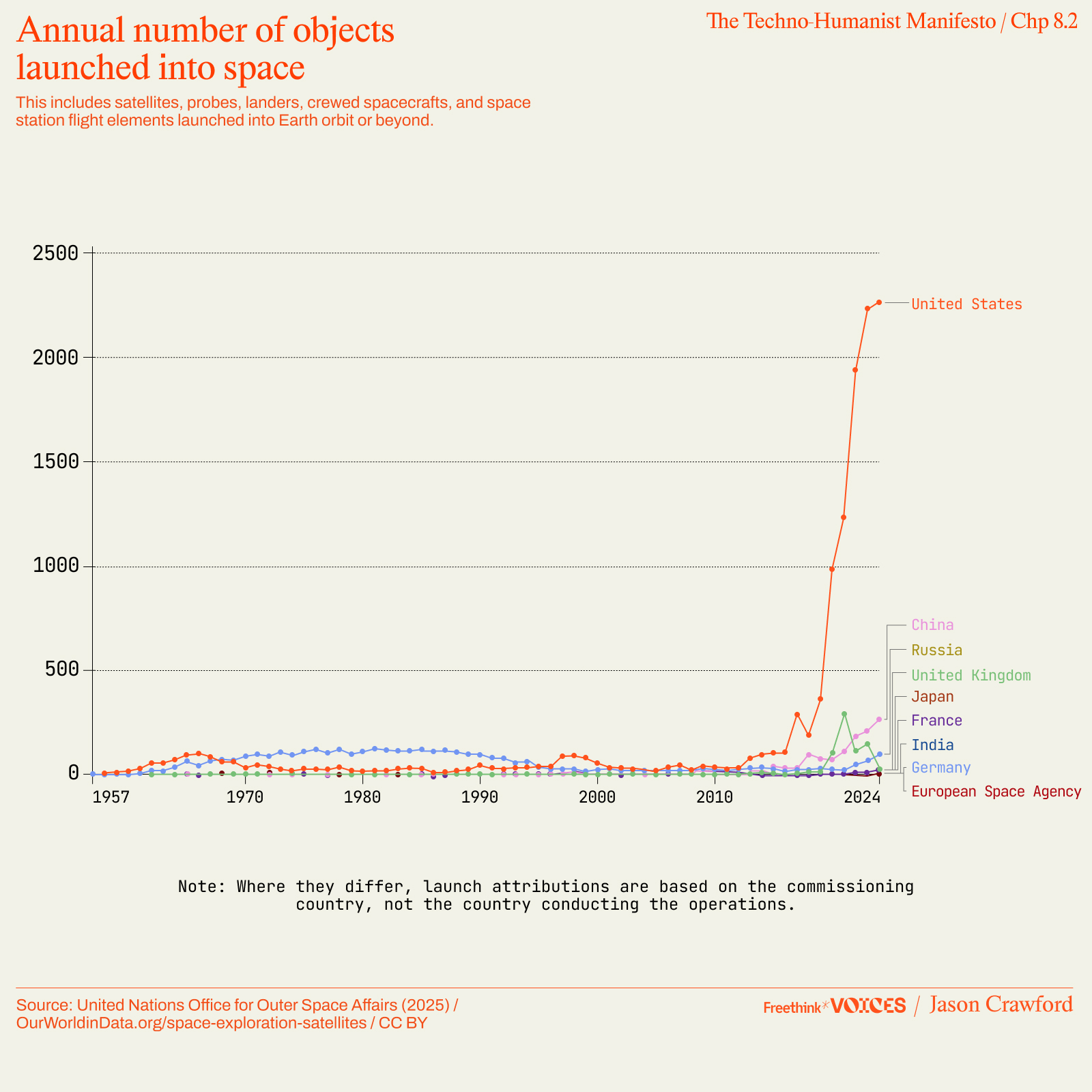
For Starship, the aspirational long-term target launch cost is $10/kg, which would expand the space economy even more dramatically.33 But by that point, they might face competition from other launch providers—such Longshot Space Technology, which is making enormous cannons that use pressurized gas to shoot cargo out of the atmosphere.34
The economic case for space is sparse right now. The best reasons to go beyond Earth orbit are tourism, science, maybe asteroid defense, and some just-emerging applications of space manufacturing.35 Other applications, such as space-based solar power or mining the Moon or asteroids, don’t seem to be economically useful in the foreseeable future.36 Some factors will inevitably push us into space if growth continues—at some point we will exhaust something on Earth, whether material resources or energy or heat dissipation37 or simply room for more people—but those limits are orders of magnitude away.
Still, space calls to us. In his famous speech on the Moon mission, John F. Kennedy invoked the British mountaineer who had wanted to climb Mt. Everest “because it’s there,” saying: “space is there, and we’re going to climb it.”38 I suspect that as soon as we can afford the luxury, we will go to space because we want to, for the sake of exploration and adventure, well before we have to for reasons of economics.
Mastery over energy
The bold, ambitious future is going to require a tremendous amount of energy.
Most people have been taught to believe that energy usage is at best a necessary evil—or perhaps that it’s not even all that necessary. Journalist Cleo Abrams reports that when she first heard a compelling case for energy abundance, it “put my brain through the BLENDER,” because she had always seen energy usage as “shameful.”39 Calling attention to a technology’s energy use is a quick and easy way to criticize it, no further explanation needed: energy is bad, therefore jet travel or AI is bad. But from a techno-humanist point of view, this logic is backwards: planes, AI, and the rest of the industrial economy are good, and therefore energy, the most fundamental enabler of the economy, is tremendously good.
Energy usage per capita, however, flatlined in the US and Europe in the early 1970s.40 While we have squeezed out some efficiency gains, creating marginally more value with the same amount of energy,41 stagnation in energy is overall a sign of stagnation in economic growth. We would be better off with more energy. J. Storrs Hall argues that lack of progress in energy density explains which technologies dreamed of in the 1960s actually arrived (such as the Internet) and which didn’t (such as the space economy).42 He suggests, in short, that energy density is why we got progress in bits but not in atoms.
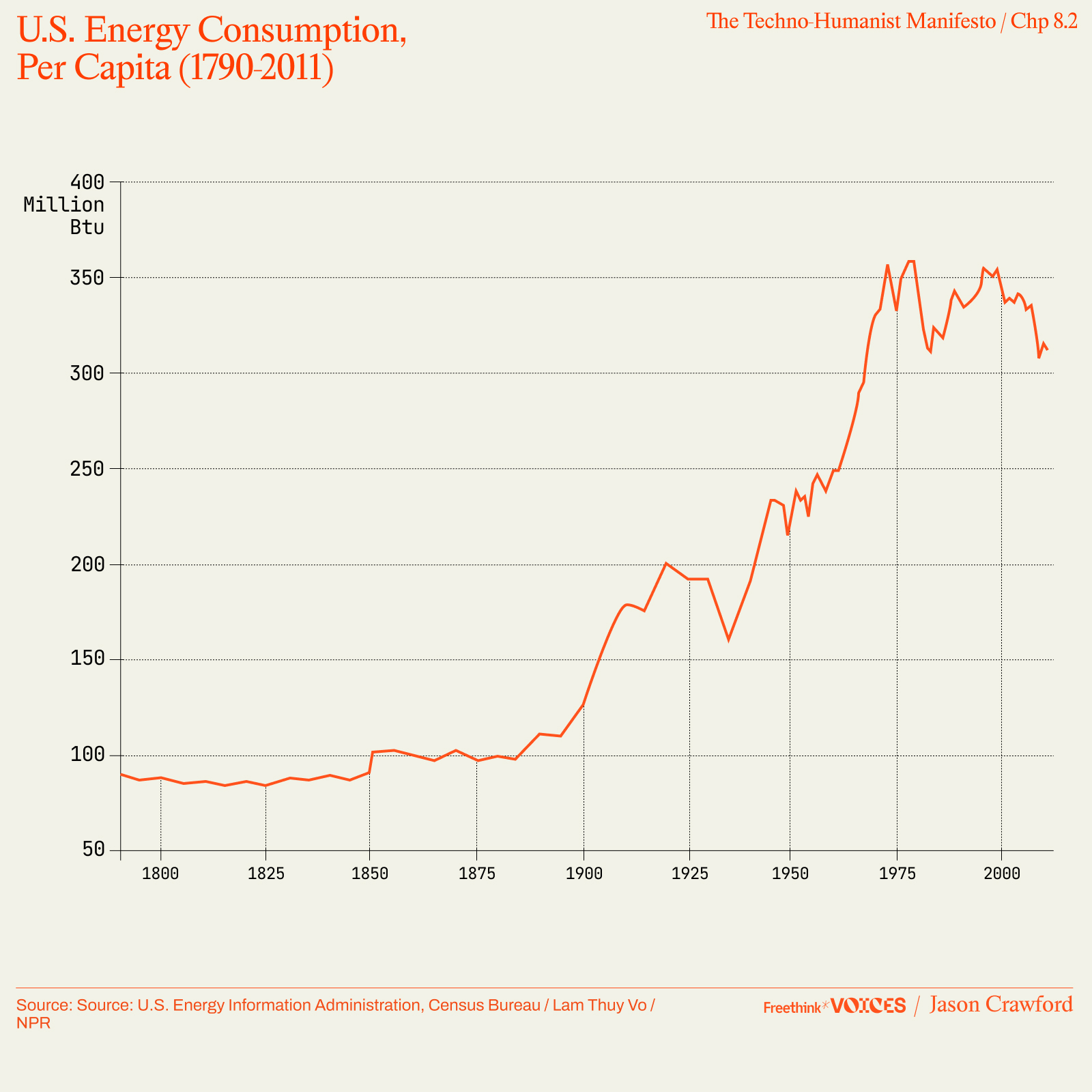
With sufficient energy, we could solve all of our water problems, making drought a thing of the past. Water is, after all, enormously abundant in the oceans; the problem with ocean water is that it’s salty and it’s below sea level—we want it to be fresh and elevated, so it can flow through our pipes to our faucets. Normally we rely on the natural water cycle to do this: an inefficient, unreliable use of solar energy. With enough industrial energy, we can control the process ourselves, desalinating water and pumping it to any elevation.43
With sufficient energy, we could solve almost all other material resource problems, too. The materials are out there; the challenge is always to gather them from dilute sources and to isolate and purify them—whether extracting metals from ore, bromine from salt water, or gasoline from crude oil. Seawater contains gigatons of metals such as lithium, nickel, copper, vanadium, molybdenum, and uranium.44 With sufficient energy, we could extract elements from common clays instead of high-grade ores, or even from landfill.45 There never need be a shortage of any resource.
Energy not only extracts material resources, it also shapes them. “A long-running story of our material world,” writes Ian MacKay, “is the constant march to more embodied energy in everything we use”: as we advanced from wood and copper, to bronze, to cast iron, to steel, to titanium, to semiconductors, the energy used per kilogram to process our materials has increased by several orders of magnitude.46 By using more energy, we’re able to make lighter and tougher materials and to tap more abundant resources. It stands to reason that the materials of the future will continue this trend.
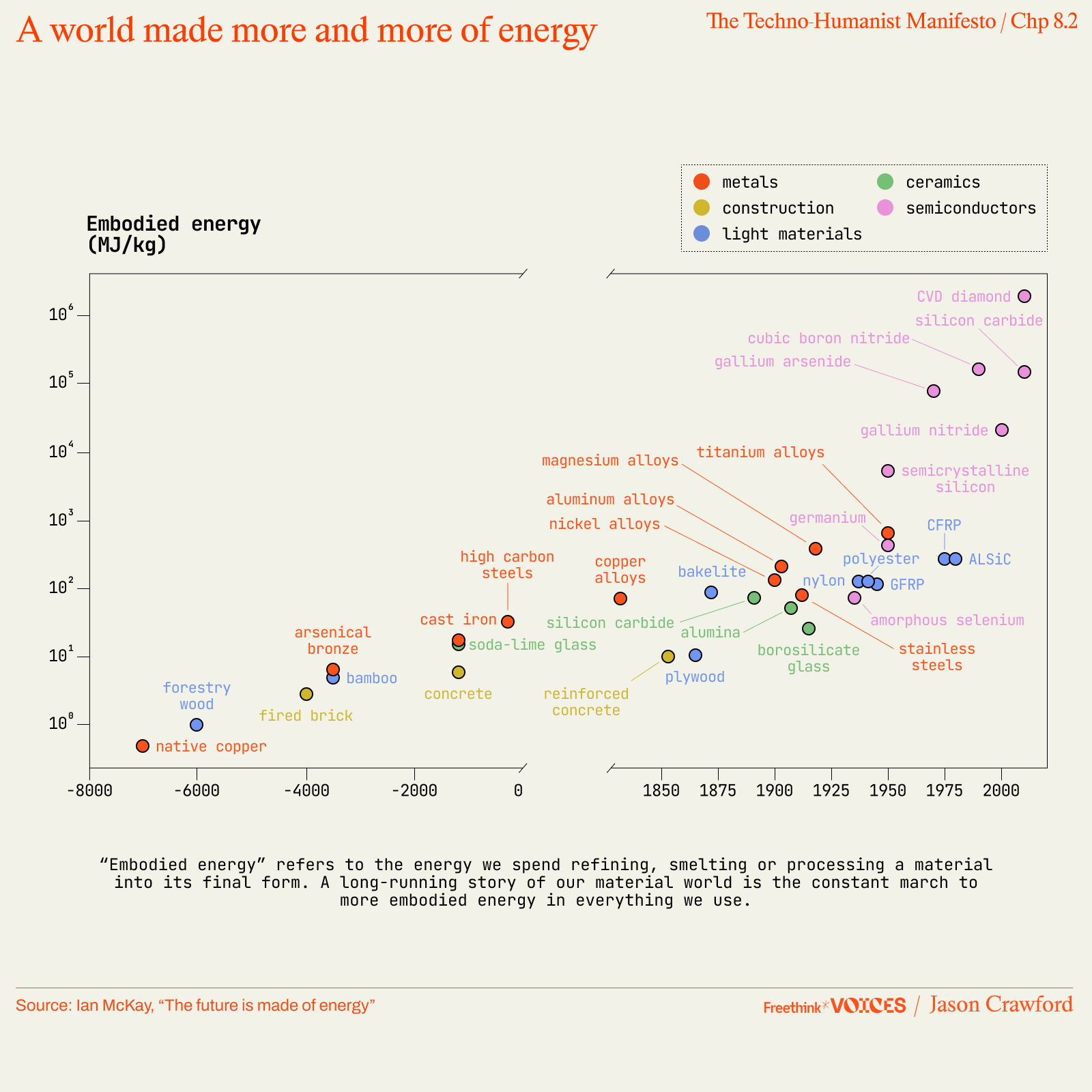
We need more energy for supersonic flight, which uses around 3x more fuel per passenger-mile than conventional subsonic jets.47 Cargo could also travel faster if we could afford to spend more energy on it.48
We need more energy for the rapid growth of AI. Although each query to an LLM uses only a small amount of energy (maybe a few watt-hours depending on the length), total AI energy usage is projected to consume on the order of 10% of US electricity by 2030.49 If the US were to reach the 100-to-1 ratio of AI to humans mentioned earlier, using an NVIDIA H100 chip as a stand-in for one human’s worth of compute, those chips alone would draw around 12 TW—more than half the entire world economy today.50
We need more energy for all the robots, too. By one estimate, there could be more than a billion humanoid robots in use by 2050, which would consume about 10% of current world electricity production.51
The need for more and more energy is ultimately the best reason to transition off of fossil fuels in the 21st century: there just aren’t enough of them. There are an estimated 13,600 TW-years of coal, oil and gas remaining in the ground; if we were to 10x world energy usage, that would only represent 68 years of energy.52 Only solar, nuclear, and geothermal have a hope of powering the superabundant energy future.
Mastery over matter
We have already come quite far in our mastery of materials and manufacturing. Our materials have gotten stronger: the tensile strength of stone, or of wood perpendicular to the grain, is on the order of 10 MPa (megapascals, a unit of pressure or stress); classical metals such as bronze and iron are in the low 100s; the best alloys of steel today are over 1,000 MPa.53 We have also improved precision: James Watt struggled with leakage from his steam engines until, using the best technology of his day, they could be made to tolerances of 1/10 of an inch; now you can buy ball bearings made to a tolerance of 80 nanometers, an improvement of over five orders of magnitude.54
There is an ultimate limit to precision: the atomic level. Making things by placing each atom exactly where we want it is a technological dream known as atomically precise manufacturing, or nanotechnology.
With nanotech, machine parts such as gears or bearings could be individual molecules, made from many atoms in exact configuration. A nanomachine such as a pump or engine, made from many such parts, might be the size of a large molecule such as a protein. A more complex machine, such as a robot, might be around the size of a cell.
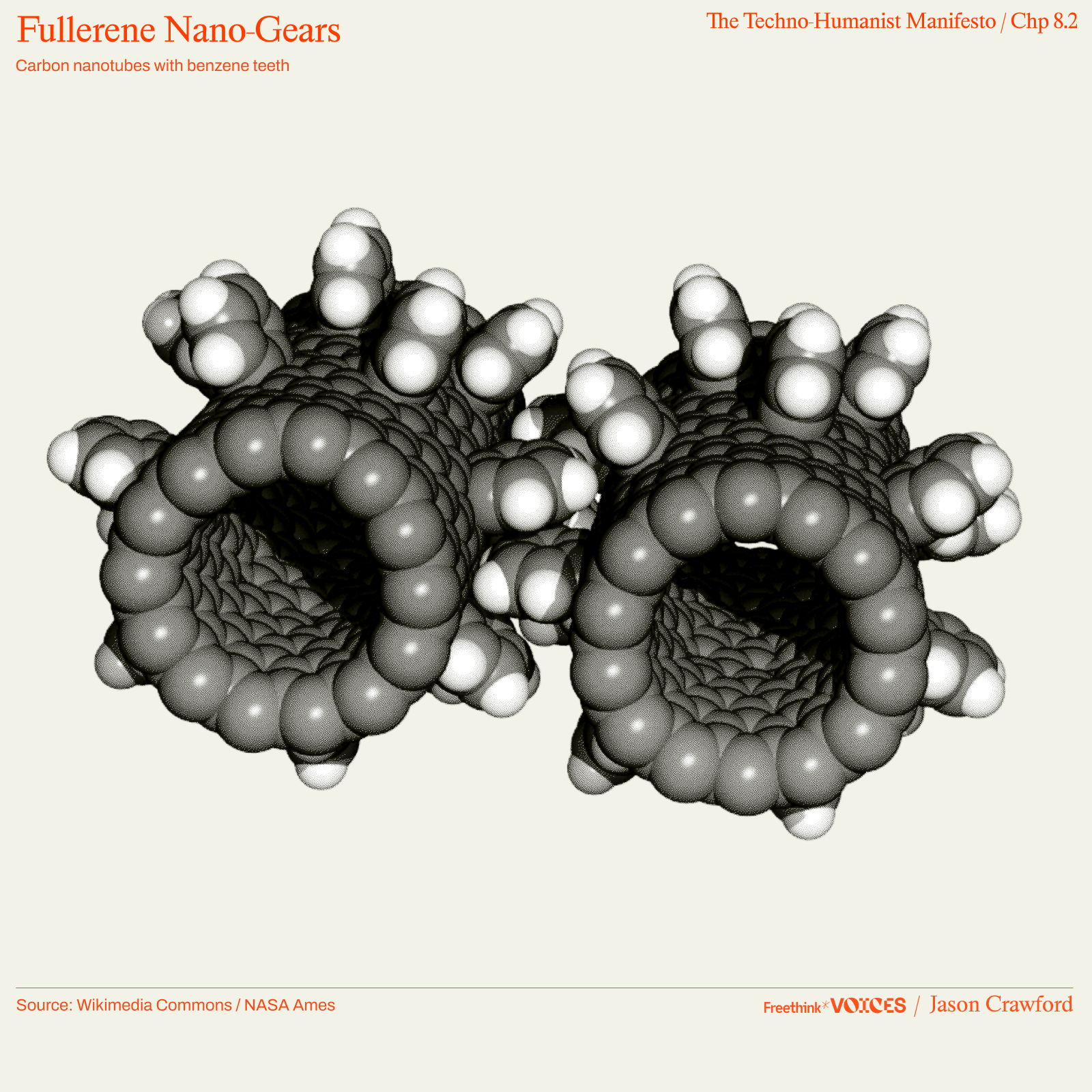
J. Storrs Hall paints the possibilities for this technological platform in his book Nanofuture. Macroscopic objects, from clothing to buildings, might be made with nano-machines built into them, in incredible numbers. Objects might be able to shape-shift: a telescoping arm, for instance, made up of 6,000 concentric cylinders each an inch long and 5 microns thick, could extend to a length of 50 feet or retract into a 1-inch puck.55 With nano-motors integrated throughout, that arm and other parts like it might appear to move on their own, “like animals.”56 Other nano-parts might give objects unique optical properties, or integrate large amounts of data storage and computing power into everyday items such as clothing.
What this enables for end users is straight out of science fiction. Nanotech synthesizers might make items directly from raw materials. A household synthesizer, like the “matter compiler” from Neal Stephenson’s Diamond Age, might create goods when they were needed; they might then be recycled afterwards for their atoms to be reused in a different configuration—no need for storage or cleaning.57 Food, too, might be synthesized directly, with no animals or crops raised for the purpose, and with better taste and nutrition.58 Thread might be made extremely strong, allowing clothing to be extremely light and flexible, like silk but much more so.59
The incredible speed of nanotech synthesis alone might dramatically lower the price of literally every physical product. Hall estimates that with mature nanotechnology, the entire capital stock of the US—“every single building, factory, highway, railroad, bridge, airplane, train, automobile, truck, and ship”—could be rebuilt in a week.60
If there is a fifth economic era, a successor to the “intelligence age,” it might be based on nanotechnology.
The possibilities for medicine are also amazing. Surgery might no longer be invasive: a thread no wider than a hair might inject an army of nanobots into the patient’s body to reconstruct tissue, avoiding all of that messy cutting and sewing and the recovery time needed for wounds to heal: “There is no reason in principle that you couldn’t have major surgery one day and play tennis, go dancing, or do a full day’s work the next.” Artificial organs might replace diseased ones and even work better than the originals. Artificial red blood cells might transport oxygen more efficiently and store enough to allow you to hold your breath all day, or more practically, to survive a heart attack. Artificial immune cells might be able to fight pathogens more efficiently, giving you resistance against all infectious disease. Other nanobots might detect and destroy cancer, clean up accumulated toxins and other cellular “garbage,” and fix other kinds of damage to cells and tissues.61
At the macro scale, it turns out that the ultimate in precision manufacturing might give us the ultimate in material strength as well. One of the strongest ways to construct things from atoms is to build a lattice of carbon, which conveniently has four covalent bonds that suit it well for such structures. Graphene, a two-dimensional honeycomb of carbon, has tensile strength over 100 GPa (if free of defects), or two hundred times that of a typical steel.62
Stronger materials might enable larger structures. Hall has proposed that with nanotech materials, we might build a “space pier,” a set of towers 100 km tall with a 300 km runway atop them. Payloads going to space might take an elevator to the top, then be accelerated along the ramp by an electromagnetic motor, saving much of the fuel required to launch from the ground; launch costs might get as low as $10/kg.63
Diamond, with its extreme stiffness, might also be used to create very small, light structures. Hall has also proposed the “Weather Machine,” a fleet of quintillions of centimeter-sized balloons floating in the stratosphere. They could be made of nanometer-thick diamond, with remote-controlled mirrors that can reflect light or allow it to pass through, forming a “programmable greenhouse gas” that can regulate temperature and direct solar energy.64
If there is indeed a fifth economic era, a successor to the “intelligence age,” it might be based on nanotechnology.
Mastery over environment
As our ambitions grow, they might reach planetary scale.
We’ve already mentioned mastering the climate by creating a system of climate control (Chapter 5). Even beyond simply controlling CO2 and temperature, we might develop technologies to control the weather, optimizing it for agriculture and for human enjoyment, and eliminating hazards such as hurricanes.65
We might reshape the land and water. Even using late 19th and early 20th century technology, we built Suez and Panama, the Hoover Dam and the Zuiderzee; Boston created its Back Bay and San Francisco its Treasure Island. In the 21st century we should be able to do much more.
Mastery over environment would also mean being able to maintain it in pristine condition. In the bold, ambitious future, we might eliminate all pollutants, toxins and carcinogens from the air, water, and soil.66 We might protect the coral reefs, and even create new ones.67 We might be able to easily rescue any species from extinction, or even to “de-extinct” long-gone species, as is being attempted now with the woolly mammoth and the dire wolf.68
And there is no reason why mastery over environment should be limited to one planet. We might develop the ability to “terraform” other planets, creating entirely new ecosystems, and doing it far faster than the geological timescales that shaped Earth.69 There are literally whole new worlds to win.
Complete mastery over nature might enable trillions of humans living everywhere on Earth, across the solar system, or even throughout the galaxy. Compared to what we know today, it would be a life without pain, suffering, or death.
But it would not be a life without effort, challenge, and striving.
Many utopias throughout history—mythological, religious, philosophical, literary—have been conceived of as unchanging: the Egyptian Field of Reeds, the Greek Elysian Fields, the biblical Garden of Eden, the Buddhist nirvana, the Chinese “Peach-Blossom Spring.” This static utopia is a final state where we have solved all problems. In some of them, there is nothing for humans to do except leisure or worship.
But there is no utopia: such a final state can never be achieved, nor would we want it if it could. The longing for final states, the static ideal, is a fundamental mistake. Fear of population growth, a desire for “sustainability,” a general disapproval of moral and social evolution, a wish to stave off the creative destruction wrought by technological change—all are mistakes of holding a fixed world as an ideal.
Nothing in the universe is static. Not the stars, once the very definition of constancy. Not the rising and setting of the Sun, which will one day cease. Not the mountains, which drift on tectonic plates. Not the universe itself, which has evolved through stages over the eons, which even now is expanding and changing, which may someday end in a vast, scattered array of black holes.
Human progress is measured by the standard of human life, and life is a process of constant motion and growth. An ideal appropriate to living organisms, and especially to humans, is not a static ideal but a dynamic one. It is not a state, but a process, with health and success judged not by deviation from a fixed target, but by the rate of improvement.
Kevin Kelly calls this “protopia”:
I don’t believe in utopias. … I have not met a utopia I would even want to live in. … our destination is neither utopia nor dystopia nor status quo, but protopia. Protopia is a state that is better than today than yesterday, although it might be only a little better.70
Let us then explicitly dispel the false vision of a static utopia and replace it with a dynamic protopia:
In the bold, ambitious future, people might not have to work—but they will not be sitting around idle. Such a life would be meaningless, and the greater we enhance human agency, the more we can fill our lives with meaning. Some people, a minority I expect, will still work—but only those who want to, only those for whom work is rewarding and fulfilling (and, like a successful entrepreneur on their second act, their work won’t have to actually earn an income on any timescale). Others will pursue knowledge and satisfy their curiosity; express their creative vision in art or music; travel and explore; spend time with family and loved ones; play games or sports. (There will always be a role for human players, because the purpose of games and sports is not to achieve a practical outcome but to experience and to witness human ability.)
There will still be problems to be solved and goals to be pursued—even if increasingly, these will seem from our perspective like luxuries: creating new forms of art and entertainment, exploring the galaxy and expanding ever outward as we fill up the space around us, answering every last question as we peer into every nook and cranny of the universe, optimizing our society for harmony and our minds for joy.
The bold, ambitious future will not be a world of uniformity and sameness. It will not be like the popular depiction of Heaven, full of angels with identical robes and harps where the only colors are shades of white. It will be marvelously diverse, with room for every individual preference, aesthetic and lifestyle.
The bold, ambitious future will not slow down. It will be far more fast-paced and exciting than anything humans have known. The future will look on our so-called fast-paced world as we look on the slow-moving centuries of the Middle Ages, or the repetitive millennia of hunter-gatherer times.
Of course, life might feel boring or stale after a thousand years, or a million—once a person has seen everything there is to see, learned the secrets of the universe, mastered every skill and game, heard every story and every melody, contemplated every idea. Perhaps there will be some way to reset ourselves, or parts of ourselves, so that we can relive those things as if for the first time. And if that turns out to be impossible or undesirable, perhaps people will simply choose, once they are a few eons old, to peacefully end their lives, in perfect satisfaction and contentment, and make room for a new life and mind to begin and do it all over again.
The bold, ambitious future is not a static Garden of Eden, but a dynamic wonderland, full of excitement, adventure, romance, exploration, curiosity, art, entertainment, play, and love. It is a paradise of human agency: the life we chose and the world we made.
1: OWID, “Share of Population Living in Extreme Poverty.”
2: We don’t have happiness or life satisfaction surveys going back 200+ years, but reconstructions based on large-scale sentiment analysis in published text, and validated against modern survey data, show relatively stable subjective well-being over time: “Historical Analysis of National Subjective Wellbeing Using Millions of Digitized Books.” This is what we would expect, given that reported well-being is not strongly correlated with per-capita GDP over the longest time periods for which we have data (see discussion in Chapter 4).
3: Verne, Robur the Conqueror; Wells, “The Argonauts of the Air” and The War in the Air
4: Schwarz, More Work for Mother. See Chapter 4, part 1, note 27.
5: OWID, “Causes of Death, High-income Countries, 2021”; OWID, “Death Rates From Cardiovascular Disease Have Fallen Dramatically.”
6: Imai et al., “Transforming Cancer Screening”; Sayour et al., “Cancer mRNA Vaccines: Clinical Advances and Future Opportunities”; NIH, “CAR T Cells: Engineering Patients’ Immune Cells to Treat Their Cancers”; Macarrón Palacios et al., “Revolutionizing in Vivo Therapy with CRISPR/Cas Genome Editing”; Lincoff et al., “Semaglutide and Cardiovascular Outcomes in Obesity without Diabetes”; Harbi, “Current Usage of Inclisiran for Cardiovascular Diseases”; Sengupta et al., “The Future of Valvular Heart Disease Assessment and Therapy.”
7: Jimenez-Mallebrera, “Gene Editing for Muscular Dystrophies”; “Gene Therapy for Cystic Fybrosis”; National Library of Medicine, “Study With AMT-130 in Adults With Early Manifest Huntington’s Disease”; FDA, “Approved Cellular and Gene Therapy Products.”
8: Lytal, “USC Stem Cell’s Journey Towards 1,000 Mini-Kidneys.”
9: Moorhouse, “First Clean Water, Now Clean Air,” Williamson, “Blueprint for Far-UVC.”
10: National Academies, Wastewater-based Disease Surveillance for Public Health Action, Introduction. SecureBio, “Delay, Detect, Defend.” Grimm et al., “Inferring the Sensitivity of Wastewater Metagenomic Sequencing for Early Detection of Viruses.”
11: Naidoo and Oliver, “Gene Drives: An Alternative Approach to Malaria Control?”
12: Hannu Rajaniemi (@hannu), “Our immune system is amazing…,” X.
13: Rajaniemi, Darkome.
14: Lowe, “Cellular Rejuvenation, For Real;” Cano Macip et al., “Gene Therapy Mediated Partial Reprogramming Extends Lifespan and Reverses Age-Related Changes in Aged Mice”; Kimmel, “Developing Reprogramming Therapies.”
15: Freeman, “Ozempic for Sleep”; Song, “Engineering Sleep.” Note that Song later decided that the genetic correlations with sleep were spurious, and is pursuing non-genetic approaches to sleep reduction: Song, “Short Sleep Variants Do Not Replicate.”
16: Alexey Guzey has speculated that Elon Musk is 99th percentile on 6 different axes (which he identifies as energy, persistence, raw mental power and creativity, ambition, risk and pain tolerance, and long-term planning and vision-making) and that this explains where there is only one person like him out of 8 billion humans. “Why is there only one Elon Musk?”
17: Tieman et al., “A chemical genetic roadmap to improved tomato flavor”; Klümper and Qaim, “A Meta-Analysis of the Impacts of Genetically Modified Crops”; Bailey-Serres et al., “Submergence Tolerant Rice.”
18: Molina, “Butter Made From Carbon Tastes Like the Real Thing”; UPSIDE Foods, “Breaking New Ground: UPSIDE Foods Makes History with First Cultivated Meat Sale in the US”; GOOD Meat, “ GOOD Meat Begins the
19: Bittencourt et al., “Bioengineering of Spider Silks for the Production of Biomedical Materials.”
20: Source: I have co-founded two software startups.
21: Clay Mathematics Institute, “The Millennium Prize Problems.”
22: See Chapter 8, part 1, note 2.
23: Ashworth, “Wear This AI Friend Around Your Neck”; META, “Introducing the New Ray-Ban.”
24: Miller School of Medicine, “Paralyzed Veteran Surgically Implanted with Neuralink Device at The Miami Project to Cure Paralysis”; Balasubramanian, “Neuralink Is Working On Vision-Enhancing Implants.”
25: Zahavi and Talvitie, “Regularities in Travel Time and Money Expenditures”; Schafer, “Regularities in Travel Demand: An International Perspective.”
26: J. Storrs Hall made this point in Where Is My Flying Car?, 145–6.
27: Boom, “United Goes Supersonic.”
28: Hall, Where Is My Flying Car?, 51–2.
29: As of July 2025. Waymo, “Where You Can Go.”
30: Kelkar et al., “Will autonomy usher in the future of truck freight transportation?”
31: OWID, “Cost of Space Launches to Low Earth Orbit.”
32: Mathieu, “A Record Number of Objects Went Into Space in 2023”; Kan, “Starlink Users Are More Satisfied Than Those on Faster Fiber Network”; Kurkowski, “List of Airlines with Starlink Internet Service”; Reuters, “Royal Caribbean to use SpaceX’s Starlink for Internet on its Cruise Ships”; Rosenberg, “How Antarctica’s history of isolation is ending—thanks to Starlink”; Pruett, “Starlink Deployment During Emergency Response”;
33: Elon Musk (@elonmusk), “Starship + Super Heavy propellant mass is 4800 tons…,” X.
34: Vance, “Two Men, One Space Gun.”
35: Dourado, “Seeing on the Far Side of the Moon”; O’Callaghan, “The Future of Manufacturing Might Be in Space.”
36: Handmer, “Space-based solar power is not a thing”; Handmer, “No really, space based solar power is not a useful idea”; Handmer, “There are no known commodity resources in space that could be sold on Earth.”
37: Balbi et al., “Waste Heat and Habitability: Constraints from
38: Kennedy, “Address at Rice University on the Nation’s Space Effort.”
39: Cleo Abram (@cleoabram), “I’ve been thinking about energy use wrong”, X.
40: OWID, “Primary Energy Consumption per Capita”; Goldstein, “Two Centuries Of Energy In America, In Four Graphs.”
41: OWID, “Energy intensity.”
42: Hall, Where Is My Flying Car?, 34.
43: Handmer, “It’s 2024 and Drought is Optional.”
44: Diallo et al., “Mining Critical Minerals and Elements from Seawater.”
45: USGS, “Bauxite and Alumina” (see “Substitutes”); Krook et al., “Landfill Mining: A critical review of two decades of research.”
46: McKay, “The Future is Made of Energy.”
47: Concorde got 15.8 passenger-miles/gallon, vs. ~33–54 for Boeing or DC planes of its era (Ross, “The Concorde Compromise: the politics of decision-making”); Boom Supersonic estimates “2-3 times as much fuel per seat than comparable premium class subsonic travel” (“Supersonic Air Travel
48: Vernon and Dourado, “Energy Superabundance: How Cheap, Abundant Energy Will Shape Our Future.”
49: You, “How much energy does ChatGPT use?”
50: An H100 draws 350 W in default configuration (“NVIDIA H100 PCIe GPU”); 34 billion of them would be a 100-to-1 ratio to the US population. Recall from Chapter 5 that world energy usage is about 20 TW.
51: Morgan Stanley, “Humanoids: A $5 Trillion Market.” A Tesla Optimus robot consumes between 100–500 W depending on activity level (Koetsier, “Tesla Bot Optimus: Everything We Know So Far”), so a billion of them would consume a few hundred gigawatts; compare to world electricity generation of about 3.5 TW (Ritchie, Rosada, and Roser, “Energy Production and Consumption”).
52: See Chapter 5, part 3 for energy reserve estimates.
53: Smil, Making the Modern World, 30, 61; Kretschmann, “Mechanical Properties of Wood.” Material strength is complicated and multi-dimensional: there is a difference between strength, hardness, and toughness; within strength there is a difference between tensile and compressive strength; within tensile strength there is a difference between deformation, necking, and fracture. Some materials, such as wood, are anisotropic, meaning they have different strength in different directions, and they sometimes use a different measure called modulus of rupture. The comparisons here are simplified.
54: Winchester, The Perfectionists, 51; Hartford Technologies, “Ball Size, Grade and Tolerance Definitions.”
55: Hall, Nanofuture, Kindle location 1783.
56: Nanofuture, Kindle location 1052.
57: Nanofuture, Kindle location 1387.
58: Nanofuture, Kindle location 1434.
59: Nanofuture, Kindle location 1488.
60: Where Is My Flying Car?, 61.
61: This paragraph summarized from Nanofuture, Chapter 17, Kindle loc 2696 ff.
62: Lee et al., “Measurement of the Elastic Properties and Intrinsic Strength of Monolayer Graphene.”
63: Nanofuture, Kindle location 2035; Where Is My Flying Car?, 267-270.
64: Where Is My Flying Car?, 272.
65: This is speculative, but the possibility is taken seriously by scientists. The National Research Council has recommended “a renewed commitment to advancing our knowledge of fundamental atmospheric processes that are central to the issues of intentional and inadvertent weather modification” (National Research Council, Critical Issues in Weather Modification Research); the World Meteorological Organization “neither promotes nor discourages the practice of weather modification” but does encourage “scientifically sound research projects” (“WMO Statement on Weather Modification”).
66: Drexler, “Engines of Creation 2.0”, 264–70; Drexler and Peterson, Unbounding the Future, Chapter 9.
67: Bay et al., “Understanding Natural Adaptation and Assisted Evolution of Corals to Climate Change”; Kleypas et al., “Designing a blueprint for coral reef survival.”
68: Colossal Laboratories, “Species.”
69: DeBenedictus et al., “The case for Mars terraforming research.”
70: Kelly, “Protopia.”
